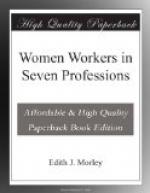“.... It is to be noted that the curriculum in girls’ schools is of a much more reasonable character than that which is commonly provided for boys, and that the more completely it is fitted to supply a good general education, the better it would be adapted to the special needs of those who wish to become clerks or secretaries. It would seem eminently desirable that such aspirants should continue at the secondary school between the ages of sixteen and eighteen, being provided with a specialised course of study ... but whenever it is possible it would be well to insist that no subject should be included which is not generally educative in the widest sense. The acquisition of such mechanical arts as stenography and typewriting should be relegated to technical colleges where, according to general testimony, proficiency can be gained by well-educated girls in a period varying from six to nine months. ‘Commercial correspondence’ is an abomination; a sufficient knowledge of the ordinary forms of letter-writing should be imparted in every course of English composition ... while the special jargon of each business or office can be readily acquired by any intelligent girl when it becomes necessary.”
There is every variety of price at the various technical training schools all over the country, from a guinea to L100. With regard to the training given in non-technical schools, the capable head of a well-equipped West End typing office writes:
“It is a pity the ordinary schools are taking it up. I know of at least one so-called secondary school which makes a speciality of ‘Commercial Training.’ The girls who take up the subject are quite the wrong kind, with absolutely no real education,... and are ready to accept anything in the way of salary. The really good schools where the girls remain till they are 18 or 19 give a better training, of course.... But I do not think the schools have any right to undertake a specialised vocational training; it must lower the standard. Every other profession has its special training after a good general education has been acquired.”
The best-known societies for protecting the interests of women clerks and secretaries are, the Association of Women Clerks and Secretaries at 12 Buckingham Street, Strand, and the National Union of Clerks at 186-188 Bishopsgate Street. These are the only approved societies under the National Insurance Act.
The Association of Women Clerks and Secretaries has been in existence for eight years, and during the last year has more than trebled its members, the clerks’ attitude towards combination having recently changed somewhat, in London at any rate. The Association has a devoted secretary and does excellent work. Its aims are:
(1) To raise the status of
women clerks and secretaries,
and
to encourage a higher standard of
practical
training.
(2) To secure a just remuneration for all grades.




